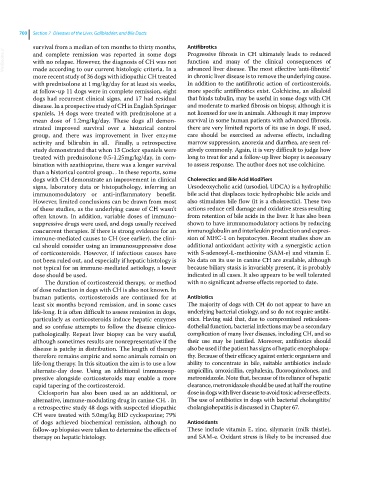Page 732 - Clinical Small Animal Internal Medicine
P. 732
700 Section 7 Diseases of the Liver, Gallbladder, and Bile Ducts
survival from a median of ten months to thirty months, Antifibrotics
VetBooks.ir and complete remission was reported in some dogs function and many of the clinical consequences of
Progressive fibrosis in CH ultimately leads to reduced
with no relapse. However, the diagnosis of CH was not
advanced liver disease. The most effective ‘anti-fibrotic’
made according to our current histologic criteria. In a
more recent study of 36 dogs with idiopathic CH treated in chronic liver disease is to remove the underlying cause.
with prednisolone at 1 mg/kg/day for at least six weeks, In addition to the antifibrotic action of corticosteroids,
at follow‐up 11 dogs were in complete remission, eight more specific antifibrotics exist. Colchicine, an alkaloid
dogs had recurrent clinical signs, and 17 had residual that binds tubulin, may be useful in some dogs with CH
disease. In a prospective study of CH in English Springer and moderate to marked fibrosis on biopsy, although it is
spaniels, 14 dogs were treated with prednisolone at a not licensed for use in animals. Although it may improve
mean dose of 1.2mg/kg/day. These dogs all demon- survival in some human patients with advanced fibrosis,
strated improved survival over a historical control there are very limited reports of its use in dogs. If used,
group, and there was improvement in liver enzyme care should be exercised as adverse effects, including
activity and bilirubin in all. Finally, a retrospective marrow suppression, anorexia and diarrhea, are seen rel-
study demonstrated that when 13 Cocker spaniels were atively commonly. Again, it is very difficult to judge how
treated with prednisolone 0.5-1.25mg/kg/day, in com- long to treat for and a follow‐up liver biopsy is necessary
bination with azathioprine, there was a longer survival to assess response. The author does not use colchicine.
than a historical control group. . In these reports, some
dogs with CH demonstrate an improvement in clinical Cholerectics and Bile Acid Modifiers
signs, laboratory data or histopathology, inferring an Ursodeoxycholic acid (ursodiol, UDCA) is a hydrophilic
immunomodulatory or anti-inflammatory benefit. bile acid that displaces toxic hydrophobic bile acids and
However, limited conclusions can be drawn from most also stimulates bile flow (it is a cholerectic). These two
of these studies, as the underlying cause of CH wasn’t actions reduce cell damage and oxidative stress resulting
often known. In addition, variable doses of immuno- from retention of bile acids in the liver. It has also been
suppressive drugs were used, and dogs usually received shown to have immunomodulatory actions by reducing
concurrent therapies. If there is strong evidence for an immunoglobulin and interleukin production and expres-
immune-mediated causes to CH (see earlier), the clini- sion of MHC‐1 on hepatocytes. Recent studies show an
cal should consider using an immunosuppressive dose additional antioxidant activity with a synergistic action
of corticosteroids. However, if infectious causes have with S‐adenosyl‐L‐methionine (SAM‐e) and vitamin E.
not been ruled out, and especially if hepatic histology is No data on its use in canine CH are available, although
not typical for an immune-mediated aetiology, a lower because biliary stasis is invariably present, it is probably
dose should be used. indicated in all cases. It also appears to be well tolerated
The duration of corticosteroid therapy, or method with no significant adverse effects reported to date.
of dose reduction in dogs with CH is also not known. In
human patients, corticosteroids are continued for at Antibiotics
least six months beyond remission, and in some cases The majority of dogs with CH do not appear to have an
life‐long. It is often difficult to assess remission in dogs, underlying bacterial etiology, and so do not require antibi-
particularly as corticosteroids induce hepatic enzymes otics. Having said that, due to compromised reticuloen-
and so confuse attempts to follow the disease clinico- dothelial function, bacterial infections may be a secondary
pathologically. Repeat liver biopsy can be very useful, complication of many liver diseases, including CH, and so
although sometimes results are nonrepresentative if the their use may be justified. Moreover, antibiotics should
disease is patchy in distribution. The length of therapy also be used if the patient has signs of hepatic encephalopa-
therefore remains empiric and some animals remain on thy. Because of their efficacy against enteric organisms and
life‐long therapy. In this situation the aim is to use a low ability to concentrate in bile, suitable antibiotics include
alternate‐day dose. Using an additional immunosup- ampicillin, amoxicillin, cephalexin, fluoroquinolones, and
pressive alongside corticosteroids may enable a more metronidazole. Note that, because of its reliance of hepatic
rapid tapering of the corticosteroid. clearance, metronidazole should be used at half the routine
Ciclosporin has also been used as an additional, or dose in dogs with liver disease to avoid toxic adverse effects.
alternative, immune‐modulating drug in canine CH. . In The use of antibiotics in dogs with bacterial cholangitits/
a retrospective study 48 dogs with suspected idiopathic cholangiohepatitis is discussed in Chapter 67.
CH were treated with 5.0mg/kg BID cyclosporine; 79%
of dogs achieved biochemical remission, although no Antioxidants
follow-up biopsies were taken to determine the effects of These include vitamin E, zinc, silymarin (milk thistle),
therapy on hepatic histology. and SAM‐e. Oxidant stress is likely to be increased due

